The Hearing Devices 3D Printing Market is estimated to be valued at USD 11.5 billion in 2025 and is projected to reach USD 19.5 billion by 2035, registering a compound annual growth rate (CAGR) of 5.4% over the forecast period.
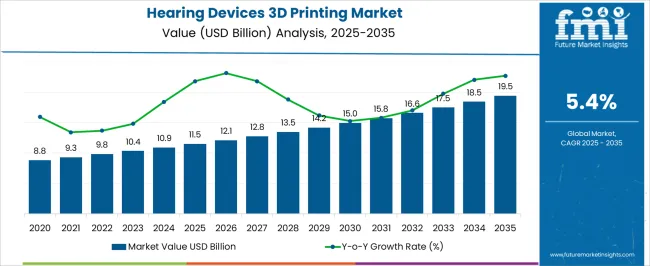
| Metric | Value |
|---|---|
| Hearing Devices 3D Printing Market Estimated Value in (2025 E) | USD 11.5 billion |
| Hearing Devices 3D Printing Market Forecast Value in (2035 F) | USD 19.5 billion |
| Forecast CAGR (2025 to 2035) | 5.4% |
The Hearing Devices 3D Printing market is experiencing significant growth due to increasing demand for personalized and highly precise hearing solutions. Rising prevalence of hearing loss across all age groups and advancements in audiology technologies are driving adoption of 3D printed devices that provide superior fit, comfort, and functionality. 3D printing enables rapid prototyping, customization, and reduced production costs while ensuring high-quality acoustic performance.
The market is further supported by technological innovations such as biocompatible materials, automated design software, and additive manufacturing techniques that allow complex geometries and patient-specific designs. Increasing awareness of personalized hearing solutions among healthcare providers and patients is encouraging wider adoption.
Regulatory frameworks supporting medical device safety, combined with rising investments in hearing care infrastructure, are facilitating market growth As the global population ages and demand for hearing assistance devices rises, the market is expected to sustain growth, driven by the ability of 3D printing to enhance device efficiency, precision, and patient satisfaction while enabling scalable and cost-effective manufacturing processes.
The hearing devices 3d printing market is segmented by hearing aids, cochlear implants, assistive listening devices, hearing protection devices, auditory training and rehabilitation, and geographic regions. By hearing aids, hearing devices 3d printing market is divided into Behind-The-Ear (BTE), Receiver-In-Canal (RIC), In-The-Ear (ITE), Completely-In-Canal (CIC), and Bone Conduction Aids. In terms of cochlear implants, hearing devices 3d printing market is classified into Single-Sided Cochlear Implants, Bilateral Cochlear Implants, Pediatric Cochlear Implants, Adult Cochlear Implants, and Electrodes And Accessories. Based on assistive listening devices, hearing devices 3d printing market is segmented into Personal Listening Devices, FM Systems, Infrared Systems, Loop Systems, and Telecommunication Devices For The Deaf (TDD). By hearing protection devices, hearing devices 3d printing market is segmented into Custom Ear Plugs, Electronic Ear Plugs, Noise-Canceling Headphones, Industrial Hearing Protection, and Musician Ear Plugs. By auditory training and rehabilitation, hearing devices 3d printing market is segmented into Online Auditory Training Programs, In-Person Rehabilitation Services, Hearing Loss Support Groups, Tele-Rehabilitation Services, and Mobile Apps For Hearing Training. Regionally, the hearing devices 3d printing industry is classified into North America, Latin America, Western Europe, Eastern Europe, Balkan & Baltic Countries, Russia & Belarus, Central Asia, East Asia, South Asia & Pacific, and the Middle East & Africa.
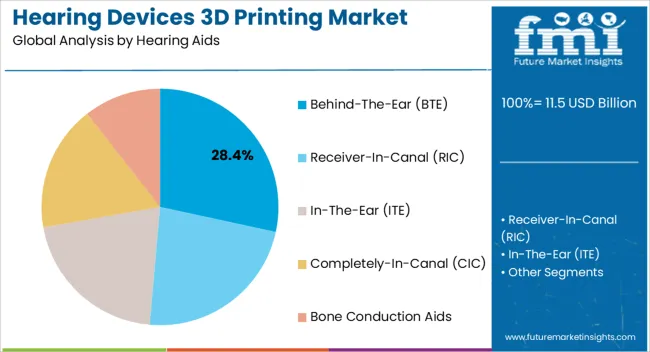
The Behind-The-Ear (BTE) hearing aids segment is projected to hold 28.4% of the market revenue in 2025, establishing it as the leading hearing aid type. Its growth is being driven by the device’s versatility, ease of fitting, and ability to accommodate a wide range of hearing impairments. 3D printing enables precise customization of BTE devices, ensuring optimal acoustic performance and comfort for patients.
Advanced additive manufacturing techniques allow rapid production, reducing lead times and improving patient satisfaction. The ability to integrate digital components, including wireless connectivity and AI-based sound optimization, further strengthens adoption. Healthcare providers and audiologists are increasingly recommending BTE devices due to their adaptability across age groups and hearing loss severities.
Continuous innovation in materials, ergonomic design, and digital integration is enhancing performance, reliability, and patient acceptance With growing awareness of personalized hearing solutions and demand for high-quality, cost-effective devices, the BTE segment is expected to maintain market leadership and remain a primary revenue contributor.
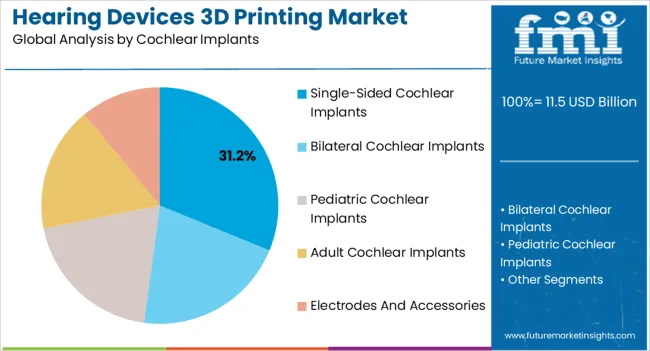
The single-sided cochlear implants segment is anticipated to account for 31.2% of the market revenue in 2025, making it the leading cochlear implant category. Growth is being driven by the increasing prevalence of single-sided deafness and the demand for effective auditory rehabilitation solutions. 3D printing enables patient-specific implant components, ensuring precise anatomical fit, reduced surgical complexity, and improved post-operative outcomes.
Advances in biocompatible materials and digital modeling allow customization of electrode arrays, housing structures, and surgical guides, enhancing both safety and performance. Adoption is further supported by healthcare provider recommendations, clinical trial successes, and growing awareness among patients seeking improved hearing functionality.
Integration with advanced audiological software and rehabilitative tools strengthens clinical effectiveness With ongoing innovation in 3D printing processes and materials, single-sided cochlear implants are expected to maintain a leading market position, offering scalable, precise, and patient-centered auditory solutions.
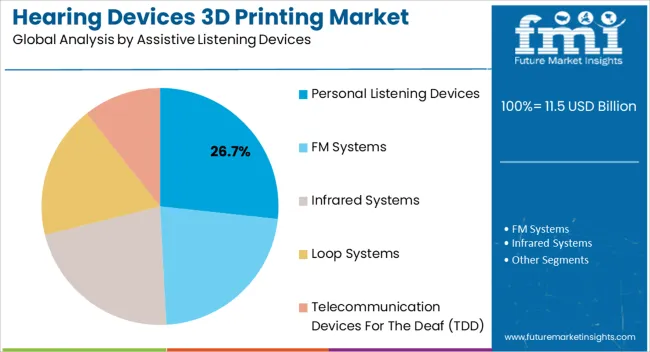
The personal listening devices segment is projected to hold 26.7% of the market revenue in 2025, establishing it as a significant growth driver. This segment benefits from rising demand for assistive listening solutions in educational, workplace, and public settings. 3D printing enables tailored designs that enhance comfort, acoustic clarity, and portability for users.
Customization options allow devices to meet specific user requirements, including hearing sensitivity, device placement, and style preferences. Integration with wireless connectivity, mobile applications, and AI-based audio processing further enhances functionality and user experience.
Increasing awareness of hearing health, regulatory support for accessibility, and adoption in professional and personal environments are fueling growth As technological advancements continue to improve precision, reliability, and cost-effectiveness, personal listening devices are expected to sustain their market relevance, supporting the broader expansion of 3D printed hearing solutions globally.
3D printing is another name for the manufacturing technique known as additive manufacturing. It is the creation of a physical product from a digital 3D blueprint of it. It uses a process called layering to add several layers or fractions of an image together until the physical manifestation of it is formed. 3D printing might seem revolutionary and futuristic, but it was first used thirty years ago! It is useful in fields as diverse as automobile, aerospace & defence, retail and even in the medical industry.
The hearing devices 3D printing market is a major component of the latter. An ageing population in the developed world and in China is spurring demand for hearing aids.
Hearing aids mass produced are all often of the same size, which may make them too small for some people or even too large. The hearing devices 3D printing market can largely solve this problem, as the equipment can be customised to an individual’s need & requirements.
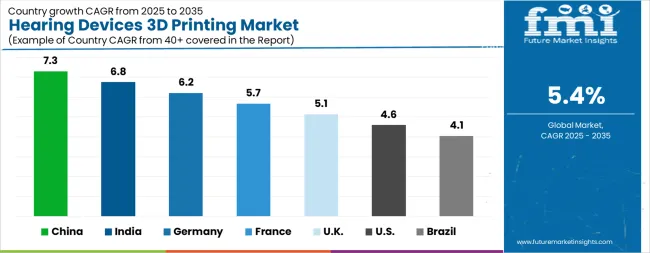
| Country | CAGR |
|---|---|
| China | 7.3% |
| India | 6.8% |
| Germany | 6.2% |
| France | 5.7% |
| UK | 5.1% |
| USA | 4.6% |
| Brazil | 4.1% |
The Hearing Devices 3D Printing Market is expected to register a CAGR of 5.4% during the forecast period, exhibiting varied country level momentum. China leads with the highest CAGR of 7.3%, followed by India at 6.8%. Developed markets such as Germany, France, and the UK continue to expand steadily, while the USA is likely to grow at consistent rates. Brazil posts the lowest CAGR at 4.1%, yet still underscores a broadly positive trajectory for the global Hearing Devices 3D Printing Market. In 2024, Germany held a dominant revenue in the Western Europe market and is expected to grow with a CAGR of 6.2%. The USA Hearing Devices 3D Printing Market is estimated to be valued at USD 3.9 billion in 2025 and is anticipated to reach a valuation of USD 6.1 billion by 2035. Sales are projected to rise at a CAGR of 4.6% over the forecast period between 2025 and 2035. While Japan and South Korea markets are estimated to be valued at USD 598.0 million and USD 326.4 million respectively in 2025.
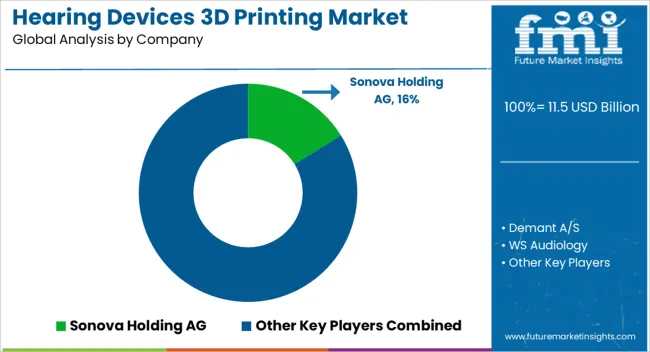
| Item | Value |
|---|---|
| Quantitative Units | USD 11.5 Billion |
| Hearing Aids | Behind-The-Ear (BTE), Receiver-In-Canal (RIC), In-The-Ear (ITE), Completely-In-Canal (CIC), and Bone Conduction Aids |
| Cochlear Implants | Single-Sided Cochlear Implants, Bilateral Cochlear Implants, Pediatric Cochlear Implants, Adult Cochlear Implants, and Electrodes And Accessories |
| Assistive Listening Devices | Personal Listening Devices, FM Systems, Infrared Systems, Loop Systems, and Telecommunication Devices For The Deaf (TDD) |
| Hearing Protection Devices | Custom Ear Plugs, Electronic Ear Plugs, Noise-Canceling Headphones, Industrial Hearing Protection, and Musician Ear Plugs |
| Auditory Training And Rehabilitation | Online Auditory Training Programs, In-Person Rehabilitation Services, Hearing Loss Support Groups, Tele-Rehabilitation Services, and Mobile Apps For Hearing Training |
| Regions Covered | North America, Europe, Asia-Pacific, Latin America, Middle East & Africa |
| Country Covered | United States, Canada, Germany, France, United Kingdom, China, Japan, India, Brazil, South Africa |
| Key Companies Profiled | Sonova Holding AG, Demant A/S, WS Audiology, Cochlear Limited, GN Store Nord A/S, Amplifon S.p.A., Starkey Hearing Technologies, Eargo Inc., Oticon A/S, Hearing Life, MediSound, and HearingLife |
The global hearing devices 3D printing market is estimated to be valued at USD 11.5 billion in 2025.
The market size for the hearing devices 3D printing market is projected to reach USD 19.5 billion by 2035.
The hearing devices 3D printing market is expected to grow at a 5.4% CAGR between 2025 and 2035.
The key product types in hearing devices 3D printing market are behind-the-ear (bte), receiver-in-canal (ric), in-the-ear (ite), completely-in-canal (cic) and bone conduction aids.
In terms of cochlear implants, single-sided cochlear implants segment to command 31.2% share in the hearing devices 3D printing market in 2025.






Our Research Products

The "Full Research Suite" delivers actionable market intel, deep dives on markets or technologies, so clients act faster, cut risk, and unlock growth.

The Leaderboard benchmarks and ranks top vendors, classifying them as Established Leaders, Leading Challengers, or Disruptors & Challengers.

Locates where complements amplify value and substitutes erode it, forecasting net impact by horizon

We deliver granular, decision-grade intel: market sizing, 5-year forecasts, pricing, adoption, usage, revenue, and operational KPIs—plus competitor tracking, regulation, and value chains—across 60 countries broadly.

Spot the shifts before they hit your P&L. We track inflection points, adoption curves, pricing moves, and ecosystem plays to show where demand is heading, why it is changing, and what to do next across high-growth markets and disruptive tech

Real-time reads of user behavior. We track shifting priorities, perceptions of today’s and next-gen services, and provider experience, then pace how fast tech moves from trial to adoption, blending buyer, consumer, and channel inputs with social signals (#WhySwitch, #UX).

Partner with our analyst team to build a custom report designed around your business priorities. From analysing market trends to assessing competitors or crafting bespoke datasets, we tailor insights to your needs.
Supplier Intelligence
Discovery & Profiling
Capacity & Footprint
Performance & Risk
Compliance & Governance
Commercial Readiness
Who Supplies Whom
Scorecards & Shortlists
Playbooks & Docs
Category Intelligence
Definition & Scope
Demand & Use Cases
Cost Drivers
Market Structure
Supply Chain Map
Trade & Policy
Operating Norms
Deliverables
Buyer Intelligence
Account Basics
Spend & Scope
Procurement Model
Vendor Requirements
Terms & Policies
Entry Strategy
Pain Points & Triggers
Outputs
Pricing Analysis
Benchmarks
Trends
Should-Cost
Indexation
Landed Cost
Commercial Terms
Deliverables
Brand Analysis
Positioning & Value Prop
Share & Presence
Customer Evidence
Go-to-Market
Digital & Reputation
Compliance & Trust
KPIs & Gaps
Outputs
Full Research Suite comprises of:
Market outlook & trends analysis
Interviews & case studies
Strategic recommendations
Vendor profiles & capabilities analysis
5-year forecasts
8 regions and 60+ country-level data splits
Market segment data splits
12 months of continuous data updates
DELIVERED AS:
PDF EXCEL ONLINE
3D Printing Dental Devices Market Growth - Trends & Forecast 2025 to 2035
3D Printing Industry Analysis in Middle East Size and Share Forecast Outlook 2025 to 2035
3D Printing Ceramics Market Size and Share Forecast Outlook 2025 to 2035
3D Printing Metal Market Size and Share Forecast Outlook 2025 to 2035
3D Printing in Aerospace and Defense Market Analysis - Size, Share, and Forecast Outlook 2025 to 2035
3D Printing Market Size and Share Forecast Outlook 2025 to 2035
3D Printing in Automotive Market Size and Share Forecast Outlook 2025 to 2035
3D Printing In Construction Market Size and Share Forecast Outlook 2025 to 2035
3D Printing Photopolymers Market Trends, Analysis & Forecast by Material, Application and Region through 2035
3D Printing Materials Market Analysis by Material Type, Form, Application, and Region from 2025 to 2035
Market Positioning & Share in the 3D Printing Metal Industry
Evaluating 3D Printing Filament Market Share & Provider Insights
3D Bioprinting Market Analysis - Size, Share & Forecast 2025 to 2035
Dental 3D Printing Material Market Trends, Growth & Forecast by Material, Product, and Region through 2035
Ceramic 3D Printing Market Size and Share Forecast Outlook 2025 to 2035
3D Printed Medical Devices Market is segmented by drug type, treatment and distribution channel from 2025 to 2035
Aerospace 3D Printing Materials Market Size and Share Forecast Outlook 2025 to 2035
Demand for 3D Printing Materials in Middle East Size and Share Forecast Outlook 2025 to 2035
Industrial 3D Printing Market Size and Share Forecast Outlook 2025 to 2035
Middle East 3D Printing Materials Market Trends 2022 to 2032

Thank you!
You will receive an email from our Business Development Manager. Please be sure to check your SPAM/JUNK folder too.
Chat With
MaRIA